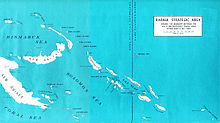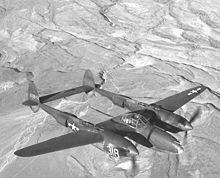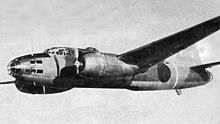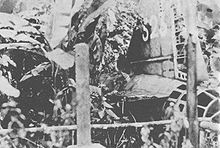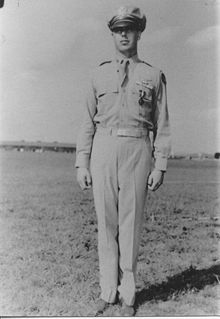- Operation Vengeance
-
Operation Vengeance Part of the Pacific Theater of World War II 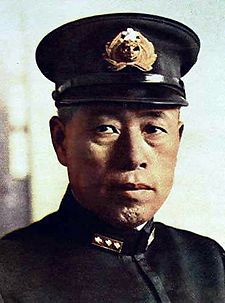
Japanese Admiral Isoroku YamamotoDate April 18, 1943 Location Bougainville in the South Pacific Result United States victory;
Admiral Yamamoto killedBelligerents  United States
United States Empire of Japan
Empire of JapanCommanders and leaders  William F. Halsey, Jr.
William F. Halsey, Jr.
 John W. Mitchell
John W. Mitchell Isoroku Yamamoto †
Isoroku Yamamoto †
 Matome Ugaki
Matome UgakiStrength 16 P-38G fighter aircraft 2 G4M1 bombers,
6 A6M2 fighter aircraftCasualties and losses 1 P-38G fighter aircraft shot down,
1 pilot killed2 bombers destroyed,
19 killed inc. Admiral Yamamoto1st Tulagi – Guadalcanal – Blackett Strait – Cartwheel – I-Go – Vengeance – New Georgia – Kula Gulf – Kolombangara – Vella Gulf – Horaniu – Vella Lavella – Naval Vella Lavella – Treasury Is. – Choiseul – Bougainville – Rabaul air raids – Cape St. George – Green Is. – Karavia BayOperation Vengeance was carried out to kill Japanese Admiral Isoroku Yamamoto on April 18, 1943, during the Solomon Islands campaign in the Pacific Theater of World War II. Isoroku Yamamoto, commander of the Combined Fleet of the Imperial Japanese Navy, was killed on Bougainville Island when his transport bomber aircraft was shot down by U.S. Army fighter aircraft operating from Henderson Field on Guadalcanal.
The mission of the U.S. aircraft was specifically to kill Yamamoto and was based on United States Navy intelligence on Yamamoto's travel plans in the Solomon Islands area. The death of Yamamoto reportedly damaged the morale of Japanese naval personnel (described by Samuel Eliot Morison as being considered the equivalent of a major defeat in battle), aided the morale of members of the Allied forces, and, controversially, may have been intended as an act of revenge by U.S. leaders who blamed Yamamoto for the Pearl Harbor attack which initiated the formal state of war between Imperial Japan and the U.S. After the war, more controversy surrounded the legacy of the mission as several of the U.S. fighter pilots involved debated for years over who should have received the aerial victory credit for the downing of Yamamoto's aircraft.
Contents
Background
Admiral Isoroku Yamamoto, commander of the Imperial Japanese Navy, scheduled an inspection tour of the Solomon Islands and New Guinea. He planned to inspect Japanese air units participating in the I-Go operation that had begun April 7, 1943, and to boost Japanese morale following the disastrous evacuation of Guadalcanal. On April 14, the U.S. naval intelligence effort code-named "Magic" intercepted and decrypted orders alerting affected Japanese units of the tour.
The original message, NTF131755, addressed to the commanders of Base Unit No. 1, the 11th Air Flotilla, and the 26th Air Flotilla, was encoded in the Japanese Naval Cipher JN-25D (Naval Operations Code Book of the third version of RO), and was picked up by three stations of the "Magic" apparatus, including Fleet Radio Unit Pacific Fleet. The message was then deciphered by Navy cryptographers (amongst them future Supreme Court Justice John Paul Stevens[1]); it contained specific details regarding Yamamoto's arrival and departure times and locations, as well as the number and types of planes that would transport and accompany him on the journey.
Yamamoto, the itinerary revealed, would be flying from Rabaul to Ballale Airfield, on an island near Bougainville in the Solomon Islands, on April 18. He and his staff would be flying in two medium bombers (Mitsubishi G4M Bettys of the 205th Kokutai Naval Air Unit), escorted by six navy fighters (Mitsubishi A6M Zero fighters of the 204th Kokutai NAU), to depart Rabaul at 06:00 and arrive at Ballale at 08:00, Tokyo time.
President Franklin D. Roosevelt ordered Secretary of the Navy Frank Knox to "get Yamamoto." Knox instructed Admiral Chester W. Nimitz of Roosevelt's wishes. Nimitz first consulted Adm. William F. Halsey, Jr., Commander, South Pacific, and then authorized the mission on April 17.
Interception mission
To avoid detection by radar and Japanese personnel stationed in the Solomon Islands along a straight-line distance of about 400 miles (640 km) between U.S. forces and Bougainville, the mission entailed an over-water flight south and west of the Solomons. This roundabout approach flight was plotted and measured to be about 600 miles (970 km). The fighters would therefore travel 600 miles out to the target and 400 miles back. The 1,000-mile flight plan, with extra fuel allotted for combat, was beyond the range of the F4F Wildcat and F4U Corsair fighters then available to Navy and Marine squadrons based on Guadalcanal. The mission was instead given to the U.S. Army's 339th Fighter Squadron of the 347th Fighter Group, Thirteenth Air Force, whose P-38G aircraft, equipped with drop tanks, would have the range to intercept and engage.
Planning for this mission was begun by Fighter Command's deputy, Marine Lieutenant Colonel Luther S. Moore, who had the P-38s fitted with a Navy ship's compass at the request of Major John W. Mitchell, commanding officer of the 339th, to aid in navigation. These fighters each carried standard armament of a 20 mm cannon and four 50-caliber (12.7 mm) machine guns, and they often carried two 150–165-US-gallon (570–620 L) drop tanks under their wings. For this raid a limited supply of 300–330-US-gallon (1,100–1,200 L) tanks was flown up from New Guinea, sufficient to provide each Lightning with one large tank to replace one of the small tanks. Despite the difference in size, the tanks were located close enough to the aircraft's center of gravity to avoid any performance problems.
Eighteen P-38s were tasked for the mission. One flight of four was designated as the "killer" flight while the remainder, which included two spares, would climb to 18,000 feet (5,500 m) to act as "top cover" for the expected reaction by Japanese fighters based at Kahili. A flight plan was prepared by the Command Operations Officer, Marine Major John Condon but was discarded for one prepared by Mitchell. He calculated an intercept time of 09:35, based on the itinerary, to catch the bombers descending over Bougainville, ten minutes before landing at Ballale airfield. He worked backwards from that time and drew four precisely-calculated legs, with a fifth leg added if Yamamoto did not take the most direct route. In addition to heading out over the Coral Sea, the 339th would "wave-hop" all the way to Bougainville at altitudes no greater than 50 feet (15 m), maintaining radio silence en route.
Although the 339th Fighter Squadron officially flew the mission, ten of the eighteen pilots were drawn from the other two squadrons of the 347th Group. A thorough, detailed briefing included a cover story for the source of the intelligence stating that a coastwatcher had spotted an important high-ranking officer boarding an aircraft at Rabaul, but the pilots were not specifically briefed that their target was Admiral Yamamoto.
The specially-fitted P-38s took off from Guadalcanal's Fighter Two airstrip beginning at 07:25. The date, April 18, had the significance of being the first anniversary of the Doolittle Raid as well as Palm Sunday. Two of the Lightnings assigned to the killer flight dropped out of the mission at the start, one with a tire flattened during takeoff and the second when its drop tanks would not feed fuel to the engines.
In Rabaul, despite urgings by local commanders to cancel the trip for fear of ambush, Yamamoto's planes took off as scheduled for the 315 miles (507 km) trip. They climbed to 6,500 feet (2,000 m), with their fighter escort at their 4 o'clock position and 1,500 feet (460 m) higher, split into two V-formations of three planes.
Mitchell's flight of four led the squadron "on the deck" with the killer flight, consisting of Captain Thomas G. Lanphier, Jr., First Lieutenant Rex T. Barber, and the spares, Lieutenants Besby F. Holmes and Raymond K. Hine, immediately behind, fighting off drowsiness, navigating by flight plan and dead reckoning. This proved to be the longest fighter-intercept mission of the war and was so skillfully executed by Mitchell that his force arrived at the intercept point one minute early, at 09:34, just as Yamamoto's aircraft descended into view in a light haze. Mitchell ordered his planes to drop tanks, turn to the right to parallel the bombers, and began a full power climb to intercept them.
Lieutenant Holmes was unable to drop his tanks and turned back to sea, followed by his wingman, Lieutenant Hine. Mitchell radioed Lanphier and Barber to engage, and they turned to climb toward the eight aircraft. The closest escort fighters dropped their own tanks and began to dive toward the pair of P-38s. Lanphier, in a sound tactical move, immediately turned head-on and climbed towards the escorts while Barber chased the diving bomber transports. Barber banked steeply to turn in behind the bombers and momentarily lost sight of them, but when he regained contact, he was immediately behind one and began firing into its right engine, rear fuselage, and empennage. Then Barber hit its left engine and it began to trail heavy black smoke. The Betty rolled violently to the left—Barber narrowly avoided a collision. Looking back, he saw a column of black smoke and assumed the Betty had crashed into the jungle. Barber headed towards the coast at treetop level, searching for the second bomber, not knowing which one carried the targeted high-ranking officer.
Barber spotted the second bomber low over the water off Moila Point just as Holmes (whose wing tanks had finally come off) and Hine attacked it. Holmes damaged the right engine of the Betty, which began emitting a white vapor trail, then he and Hine flew over the damaged bomber. Unknown to them, this bomber carried Chief of Staff Vice Admiral Matome Ugaki and part of Yamamoto's staff. Barber was the next airman to attack the stricken bomber—his hits caused the bomber to shed metal debris which collided with and damaged his own aircraft. The bomber descended and crash-landed in the water. Ugaki and two others survived the crash and they were later rescued. Barber, Holmes and Hine were attacked by Zeros, Barber's P-38 receiving 140 hits. Holmes and Barber each claimed a Zero shot down during this melee, although Japanese records show that no Zeros were lost. The top cover briefly engaged reacting Zeros without making any kills and Mitchell observed the column of smoke from Yamamoto's crashed bomber. Hine's P-38 had disappeared by this point, presumably crashed into the water. Running close to point-of-no-return fuel levels, the P-38s broke off contact and returned to base, with Holmes so short of fuel that he was forced to land in the Russell Islands. Hine was the only one who did not return. Warrant Officer Kenji Yanagiya, one of the six Japanese escort pilots, reported pursuing and downing a P-38 over Kolombangara.
Aftermath
As he approached Henderson Field, Lanphier radioed the Guadalcanal fighter director that "That son of a bitch will not be dictating any peace terms in the White House", breaching security on the mission. Immediately on landing (his plane was so short on fuel that one engine quit during landing rollout) he again put in a claim for shooting down the bomber, relating that when he turned to engage the escort Zeroes he shot the wing off one, flipped upside down as he circled back towards the bombers, and saw the lead bomber turning a circle below him. He stated he came out of his turn at a right angle to the circling bomber and fired, blowing off its right wing. He stated that he witnessed Barber shoot down another bomber which also crashed in the jungle. Holmes put in a claim for the Betty that crashed into the water, so it was assumed that three bombers had been downed. The fifteen surviving pilots were not debriefed after the mission because this formal interrogation did not exist in the procedures on Guadalcanal at that time, and thus it was never formally established that no one else witnessed Lanphier's claim.
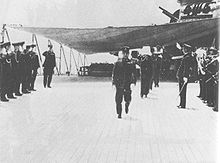 Yamamoto's ashes return to Japan at Kisarazu aboard battleship Musashi on May 23, 1943.
Yamamoto's ashes return to Japan at Kisarazu aboard battleship Musashi on May 23, 1943.
The crash site and body of Admiral Yamamoto were found the next day in the jungle north of the coastal site of the former Australian patrol post and Catholic mission of Buin (which was re-established, after the war, several kilometres inland) by a Japanese search and rescue party, led by Army engineer Lieutenant Hamasuna. According to Hamasuna, Yamamoto had been thrown clear of the plane's wreckage, his white-gloved hand grasping the hilt of his katana, still upright in his seat under a tree. Hamasuna said Yamamoto was instantly recognizable, head dipped down as if deep in thought. A post-mortem of the body disclosed that Yamamoto received two wounds, one to the back of his left shoulder and one to his left lower jaw that exited above his right eye. Whether the admiral initially survived the crash has been a matter of controversy in Japan.
In Japan this became known as the "Navy kō incident"(ja:海軍甲事件). It raised morale in the United States and shocked the Japanese who were officially told about the incident only on May 21, 1943. To cover up the fact that the Allies were reading Japanese code, American news agencies were told the cover story originally created for briefing the 339th, that civilian coastwatchers in the Solomons saw Yamamoto boarding a bomber in the area and then relayed the information by radio to American naval forces in the immediate area.
Controversy
Lanphier initially received credit for the kill of Yamamoto's bomber, but the other pilots on the mission were immediately skeptical. Although one of the most expertly-executed missions in history, the interception was subsequently marred by controversy over who actually shot down Yamamoto and by Navy outrage over unauthorized releases of operational details to the press, including an October 1943 issue of Time Magazine which featured articles on both the shootdown and Lanphier by name. Mitchell had been nominated for the Medal of Honor for the mission, but as a result of the security issues this was downgraded to the Navy Cross, which he and all the pilots of the killer flight were subsequently awarded.
After the war it was found that none of the escorting Japanese fighters were shot down—only one was damaged enough that it required a day of repair at Buin—and Lanphier was stripped of his claim for a Zero shot down. Since other Zero fighters were taking off from nearby Kahili airfield, both Barber and Holmes were allowed their claims during the second combat. Also records confirmed that only two bombers had been shot down, not three, and subsequently the Air corps officially awarded "half kills" to Lanphier and Barber for the Yamamoto shootdown. A video-taped interview in 1985 with one of the escorting Zero pilots, Kenji Yanagiya, appeared to corroborate Barber's claim, but the Air Force declined to reopen the issue.
Rex Barber then sued in Federal Court to have the ruling of the Secretary of the Air Force overturned and the opposing claims re-investigated, but the court refused to intervene. But in 2003, he was officially credited with the sole kill after an inspection analyzed the crash site and determined the path of the bullet impacts, thereby validating Barber's account and invalidating Lanphier's claim.[citation needed] In the May 2006 issue of Air Force Magazine, Douglas S. Canning, a former member of the 347th Fighter Group who flew the Yamamoto mission (Canning escorted Lt. Holmes back to the Russells) and was friends with both Lanphier and Barber, published a letter in which he stated that Lanphier, in addition to writing the official report, medal citations, and several magazine articles, had also written a detailed manuscript, never published, claiming he alone shot down Yamamoto. Until reading that manuscript, Barber had been willing to share half credit for the kill. Canning cites the testimony of the Japanese Zero pilot, Yanagiya, that Yamamoto's Betty crashed 20 to 30 seconds after being hit by fire from a P-38, and from Admiral Ugaki on the second Betty that Yamamoto's plane crashed 20 seconds after being struck. Canning stated categorically that the P-38Gs flown that day did not have aileron boost to assist in turning (as did later models) and that it was physically impossible for Lanphier's aircraft to have made the 180 degree turn he claimed in order to shoot down Yamamoto.
Present day
The tail number of Yamamoto's aircraft was T1-323.The wreckage and crash site[2] are now tourist attractions near Buin, Bougainville Island. The left wing of this aircraft was subsequently removed intact and then placed in the Isoroku Yamamoto Family Museum located in Nagaoka, Japan (Niigata Prefecture) because of the scavenging of this site.
Notes
References
- Davis, Burke (1969). Get Yamamoto. New York: Random House. ASIN B0006BZ2OC.
- Davis, Donald A. (2005). Lightning Strike: The Secret Mission to Kill Admiral Yamamoto and Avenge Pearl Harbor. New York: St. Martin's Press. ISBN 0-312-30906-6.
- Glines, Carroll V. (1990). Attack on Yamamoto. New York: Crown (1st edition). ISBN 0-517-57728-3.
- Hammel, Eric (1992 (2000 reissue)). Aces Against Japan: The American Aces Speak. Pacifica Press. ISBN 0-935553-43-6.- Contains interview with Besby Frank Holmes.
- Hammel, Eric (1996). Aces Against Japan II: The American Aces Speak. Pacifica Press. ISBN 0-935553-14-2.- Contains another interview with Besby Frank Holmes.
- Kyodo News (September 29, 2008). "Use of outdated code led to ambush that killed Yamamoto, U.S. files show" (Newspaper article). Japan Times. http://search.japantimes.co.jp/cgi-bin/nn20080929a3.html. Retrieved September 29, 2008.
Further reading
- Canning, Douglas S. (May, 2006, Volume 89, Number 5, pp 7-8). "Who Shot Down Yamamoto?, letter,". Air Force Magazine. Arlington, VA, USA: Air Force Association.
- Grant, Rebecca (March, 2006, Volume 89, Number 3, p. 62). "Magic and Lightning". Air Force Magazine. Arlington, VA, USA: Air Force Association.
- Holley, Joe (July 27, 2006, page B7 (Obituaries)). "Besby Frank Holmes; WWII Fighter Pilot". The Washington Post. Washington, DC, USA.- Obituary on the death of Lt. Col. Frank Holmes.
- Kahn, David (1996). "Chapter 17: The Scrutable Orientals; pp 595-601". The Codebreakers: The Comprehensive History of Secret Communication from Ancient Times to the Internet, Revised and Updated. New York, NY, USA: Scribner. ISBN 0684831309.
Fiction
- In his novel Cryptonomicon, Neal Stephenson wrote an account of the assassination events from Yamamoto's viewpoint.
- In The West Wing episode "We Killed Yamamoto," President Bartlet mulls over whether to authorize the assassination of a terrorist leader.
Categories:- Conflicts in 1943
- Imperial Japanese Navy
- Military history of Japan during World War II
- Pacific Ocean theater of World War II
- 1943 in the Solomon Islands
- Aerial operations and battles
- Battles and operations of World War II involving the Solomon Islands
- Assassinations
- Aircraft shootdowns
Wikimedia Foundation. 2010.

